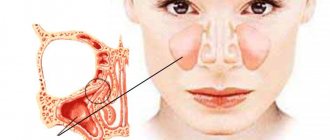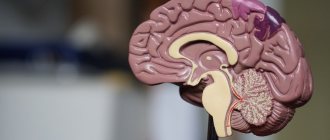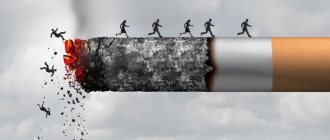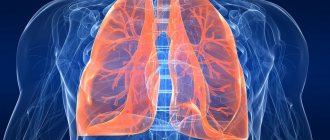Saturation (English saturation - “saturation”) of blood with oxygen shows how much of this vital gas for organs is currently contained and circulating in the blood. The indicator is expressed as a percentage. Low saturation, including during coronavirus, indicates hypoxemia, which requires urgent action. It is necessary to increase the level of oxygen in the lungs and blood to prevent complications and sometimes to save the patient's life.
Blood oxygen saturation is measured with a special device - a pulse oximeter. With the help of this express analysis, emergency doctors can obtain objective information about the state of the patient’s respiratory and circulatory system, as well as quickly make a decision on hospitalization and oxygen support. It is not always possible to quickly perform a CT scan of the lungs. If a patient’s saturation is clearly reduced during COVID-19, this most likely indicates a viral infection of the lungs—pneumonia.
Measuring blood oxygen saturation with a pulse oximeter device allows emergency teams to identify seriously ill patients with likely extensive lung damage caused by COVID-19, and also quickly make decisions about hospitalization and the necessary additional oxygen support.
If a patient with coronavirus has such a device at home, then he can carry out monitoring on his own, however, it is important to understand that pulse oximetry (measurement of saturation) does not replace a visual assessment of the condition of the lungs (CT of the lungs), and an incorrect interpretation of this indicator can only frighten the patient and mislead ambulance or cost the patient his life.
A patient with a new coronavirus infection and doctors should not focus solely on the saturation indicator - the measurement result highly depends on a number of third-party factors: the sensitivity of the device, lighting, and the color of the patient’s skin. Meanwhile, if you rely on this indicator as the main one (without spirometry and CT), there is a high probability of an inadequate assessment of a person’s health - in severe pneumonia, the saturation may remain normal for some time, and then drop sharply. At night, saturation decreases even in a healthy person.
In this material we will examine the main issues related to saturation during coronavirus.
What is saturation?
Saturation is an indicator of the saturation of blood with oxygen, which comes from the pulmonary alveoli. Together with blood, oxygen is transported to organs and tissues. A decrease in saturation during COVID-19 indicates hypoxemia, the likely cause of which is viral infection of the lungs. The hypothesis can be confirmed or refuted by computed tomography - during a visual assessment of the lungs.
Diagnostics
The diagnosis of atelectasis pneumonia can be confirmed by instrumental and laboratory tests:
- A blood test shows signs of bacterial inflammation - increased levels of white blood cells and sediment.
- Biochemical analysis determines the inflammatory marker - C-reactive protein.
- A chest radiograph reveals the core of the lesion.
- Computed tomography and magnetic resonance imaging can identify the cause of atelectasis (bronchial obstruction, tumor), as well as determine the exact location of the lesion.
The X-ray picture of normal and atelectatic pneumonia is different. In the first case, we are dealing with focus in the form of a lighter (in the negative) area with fuzzy blurred edges. In this case, both lungs are the same size.
With atelectasis pneumonia in the images, the focus of infiltration is combined with symptoms of collapse of the entire lung or a separate lobe:
- reduction in volume with decreasing transparency of the fabric:
- absence of a pulmonary pattern in the affected area;
- displacement of the mediastinal organs towards the diseased lung;
- high position of the slot dome on the side of the collapse.
With massive changes, a compensatory increase in lung aeration on the healthy side may be observed.
Differential diagnosis is carried out:
- For “classic” bacterial or viral pneumonia (without symptoms of lung collapse).
- In the case of a lung tumor, there are clearer, even contours. Lymphadenopathy may be found in the mediastinum.
- In case of a pulmonary infarction, the photo shows shortening and expansion of the apex of the lung, a sharp increase in pressure in the right side of the heart. Additionally, characteristic changes in the ECG recording are observed.
What is the normal saturation level for a healthy person?
The norm for a healthy person is SpO2 = 95-99 (or 100)%. The rate of blood oxygen saturation depends on the individual characteristics of the human body, for example, on the presence or absence of anemia, apnea, chronic diseases of the respiratory and cardiovascular systems, bad habits, and age. At night, each person's saturation decreases, and the differences can be significant. For example, in people with chronic diseases of the respiratory system (COPD, apnea), who have adapted to a constant lack of oxygen, the rate can drop to 90% (in the deep sleep phase).*
According to the observations of doctors working in hospitals with seriously ill patients who are on oxygen, the most dangerous time is from 3 to 7 am. At this time, the largest number of deaths are recorded due to decreased saturation, or more precisely due to oxygen hypoxemia.
RE Gries, LJ Brooks, Normal oxyhemoglobin saturation during sleep. How low does it go? K. Szabó, F. Ihász, The effect of reduced oxygen saturation during sleep on depression, 2020
Cost of treatment for allergic bronchitis
The cost of treatment for allergic bronchitis for each patient is calculated individually, taking into account factors such as:
- degree of neglect of the pathology;
- presence of associated complications
- duration of therapy, etc.
It's cheaper with us
- Beneficial programs for annual placement, pregnancy management, medical examination and “check-up” with discounts from the price list to 25%
- Discounts for disabled people, veterans, pensioners 10%
- Discount on deposit program up to 25%
- Discounts on promotions and seasonal offers up to 50%
Why does saturation decrease during coronavirus?
Not all patients with COVID-19 have a decrease in saturation, but only with the development of a complication - viral pneumonia. A decrease in saturation indicates probable respiratory failure. If a coronavirus infection has penetrated the lung tissue, and a person’s immune system cannot cope with it, a destructive process begins in the lungs - the alveolar septa (and interstitium) are damaged and inflamed, and the alveoli themselves are filled with liquid exudate - normally they are filled with air and are the starting point of transportation oxygen to organs, including the heart and brain. Since there is no damage to the bronchial tree with coronavirus, a decrease in saturation in a patient may indicate a reduction in the functional areas of the lung tissue.
If coronavirus saturation is below 95%, the patient may be hospitalized.
Pathogenesis of obstructive bronchitis in children
The pathogenesis of the disease has a complex structure. When a virus invades, inflammatory infiltration of the mucous membrane lining the bronchi occurs. Various groups of leukocytes migrate in large numbers in its tissue. Inflammatory mediators are released - histamine, prostaglandin, cytokines. Edema of the bronchial wall develops.
Then the smooth muscle fibers in the wall of the bronchi contract, causing bronchospasm to develop. Goblet cells activate the secretion of bronchial secretions. Mucus has increased viscosity. A disorder of the ciliated epithelium occurs. Mucociliary insufficiency develops. The process of coughing up mucus is disrupted.
The lumen of the respiratory tract is blocked by bronchial secretions. This creates ideal conditions for the proliferation of the bronchitis pathogen. The submucosal and muscular layer of the bronchi is exposed to inflammation. Peribronchial interstitial tissue is included in the process. Lung tissue is not involved in inflammation.
Why measure saturation during coronavirus?
Coronavirus saturation is measured to quickly detect life-threatening hypoxemia. In this way, the severity of the disease is determined and a decision is made on further actions: hospitalization, oxygen support, computed tomography.
In foreign literature there is the term “silent hypoxemia”, which appeared only recently, during the COVID-19 pandemic, when it became clear that a fairly large percentage of patients were admitted to the hospital with an acute lack of oxygen, disproportionate to the symptoms. It turns out that patients can breathe, do not choke, there is no strong cough and no fever, while the lungs are severely damaged, saturation is critically low, and additional oxygen is needed.
Can a patient with symptoms of coronavirus somehow suspect that he has a lack of oxygen due to pneumonia? Yes.
Prevention
Measures to prevent obstructive bronchitis in children include:
- prevention of viral diseases;
- timely vaccination;
- hypoallergenic environment;
- hardening;
- health improvement at resorts.
It is necessary to stop the child for a medical check-up with a pediatrician or pediatric pulmonologist.
The baby has not yet developed basic defense mechanisms. Their body is susceptible to the rapid development of complications. If symptoms of illness appear, consult a doctor immediately. He will make the correct diagnosis and prescribe treatment.
The article is intended for parents of patients with a diagnosis established by a doctor. Information from it must not be used for self-diagnosis or used as a guide for treatment.
Symptoms of decreased saturation
- Try holding your breath for a few seconds - if you can't help but breathe as long as before, and this action is causing difficulty, it makes sense to measure your saturation.
- Your breathing and heart rate have increased.
- The skin turned pale and acquired a bluish tint (face, lips, fingertips).
- You feel very tired and sleepy.
- My head hurts and feels dizzy, I have problems with memory and concentration.
- You are experiencing some symptoms of a respiratory system disease: shortness of breath, discomfort and unusual sensations in the chest, coughing.
Breathing exercises by A. N. Strelnikova: history of origin
The author of the unique breathing technique is the opera diva Alexandra Nikolaevna Strelnikova. At the peak of her career, she suddenly lost her voice. But the woman did not give up and, together with her mother, developed a set of exercises. They are based on an understanding of the functions of the respiratory organs: breathing, speaking, screaming, singing. It is the last one that is the most complex, therefore, with its restoration, others preceding it are also stimulated.
Who knows best how to handle the voice? Of course, a professional singer. Finding herself in a situation where she lost her voice, Strelnikova developed a unique method for restoring it.
The developed technique turned out to be effective for restoring the voice, its development, and has a positive effect on other systems of the body.
Medical recognition of the technique
For a long time, official medicine did not recognize the therapeutic and preventive properties of gymnastics. Only in 1972 did the State Institute of Patent Examination issue the corresponding Patent to the author. Along with this, the effectiveness and efficiency of paradoxical charging has been recognized in medical circles.
What to do if saturation drops?
Don't panic about low saturation - normal vital signs can be quickly restored, and even a reading of 70% within a few days is compatible with life, and the chances may be even higher if the patient has, for example, chronic obstructive pulmonary disease, and to a low level oxygen, his body has already adapted. Saturation may drop for several days.
However, if during coronavirus the saturation drops to 95%, 93, 90...%, and all measurements are made correctly (it is important to check that the pulse oximeter has an adequate battery level, and that the device itself is registered as a medical device and not purchased from dubious manufacturer) - you need to call an ambulance.
Why can pulse oximetry data be misleading?
It is important to understand that the result of pulse oximetry can be influenced by: the sensitivity of the device (including battery charge), lighting, and the color of the patient’s skin (the darker, the higher the indicator, which does not reflect the real state of affairs).
The concept of “saturation rate” is very arbitrary. It happens that patients with signs of coronavirus infection and a mobile non-invasive device for measuring saturation begin to panic and call an ambulance if the oxygen in the blood drops, for example, to 93%. To do this, let’s look at the data from the conditional norm table:
When is hospitalization and oxygen support needed?
- If the indicator has dropped to 93% and the patient feels unwell (hypoxemia, respiratory failure, respiratory symptoms are severe).
- With a significant percentage of lung damage on CT (> 50%, with CT-3, CT-4).
- Old age of the patient.
- Concomitant chronic diseases of the respiratory system.
- Concomitant chronic diseases of the cardiovascular system.
- Initially low saturation due to anemia.
- Pregnant women.
- Patients with immunodeficiency.
- Obese patients.
- For diabetes mellitus.
A decrease in saturation is dangerous primarily for these groups of patients.
If a hospitalized patient's saturation is low and does not rise even with oxygen, then, according to the current recommendations of resuscitators, the patient undergoes tracheal intubation.
Is it possible to quickly increase the saturation on your own?
Before the ambulance and oxygen therapy arrive, the patient can take the following measures:
1. Do breathing exercises
Sit up straight, lower your shoulders, straighten up and try to relax.
Exercise 1
- Raise one hand up and grab the floor lamp/beam/door handle to secure the position of your hand.
- Place your other hand on the diaphragm. Breathe deeply, lifting your diaphragm as you inhale.
Exercise 2
- Continue to hold one arm up while keeping the other extended forward.
- As you inhale, turn your body towards your outstretched arm (if your left hand is raised, turn your body to the left and vice versa).
Exercise 3
- Breathe deeply with one arm raised up. The hand is fixed on any object (floor lamp) or wall.
Open the windows and ventilate the room.
Lie on your stomach for up to 30 minutes.
Important! Due to individual anatomical characteristics, elderly patients should not lie on their stomach - compression of the respiratory organ is possible.
There is no evidence that any medications can effectively increase saturation in a coronavirus patient. However, in the absence of individual intolerance and the presence of aspirin in the home medicine cabinet, the use of this drug is acceptable.
The anticoagulant aspirin is associated with a reduction in the need for mechanical ventilation and admission to the intensive care unit, as well as a reduction in mortality in patients hospitalized with COVID-19.
In general, doctors who worked with seriously ill patients have repeatedly noted that oxygen therapy, or rather the constant stay of the patient “on oxygen,” is less effective than breathing exercises. The patient must breathe independently, under the supervision of medical personnel, “kneading” and stimulating the lungs.
Important! Performing the popular exercise with “inflating” balloons is not permissible in cases of lung damage KT-2, KT-3, KT-4 and especially in elderly patients, since the damaged and overstretched pulmonary matrix may simply not withstand the load.
Treatment of obstructive bronchitis in children
Children with bronchitis are often treated on an outpatient basis. Indications for hospitalization include age up to one year, the child’s serious condition, and the presence of concomitant pathologies. The main treatment is etiotropic therapy. It includes antiviral or antibacterial drugs.
Pathogenetic therapy includes selective bronchodilators or inhaled glucocorticosteroids. They are inhaled through a compressor nebulizer. The following drugs are prescribed as symptomatic therapy:
- diluting sputum - they facilitate its evacuation;
- expectorants - activate the movements of the cilia and promote coughing;
- antipyretics;
- non-steroidal anti-inflammatory drugs;
- restoratives (vitamins, immunomodulators).
During the recovery period, physiotherapy, massage and breathing exercises are prescribed.
How to increase saturation after viral pneumonia?
If even after suffering from coronavirus the saturation is slightly reduced, then this is normal - the lung tissue needs time to restore the previous vital capacity of the respiratory organ. Breathing exercises (see Strelnikova’s set of breathing exercises) and walks in the fresh air with moderate physical activity are extremely useful.
To prevent aggressive adhesions in the lungs in patients with fibrous changes evident on CT; usually with CT-4, CT-3, less often with CT-2 and very rarely with CT-1, antioxidant therapy for pulmonary fibrosis is prescribed, which includes a diet enriched with antioxidants, acetylcysteine, and vitamins E (if there are no allergies).
To clarify the diagnosis and causes of reduced saturation after coronavirus, CT control is important.
About the benefits of proper breathing
Breathing exercises are beneficial for patients of any age and gender. But breathing exercises are especially important for bronchitis and pneumonia, as it helps cleanse the bronchi and makes breathing easier for the patient.
The main result that such exercises provide is improved respiration in tissues and oxygen absorption. This determines the vital activity of all cells of our body, and as a result, all organs and systems, not only respiratory ones, work better.
Thanks to proper breathing and exercise therapy, you can not only treat the disease, but also maintain your health during the remission stage. And breathing exercises for chronic bronchitis should become a way of life for the patient. Exercise also helps improve overall immunity.
Much depends on the air you inhale. The air should be cool and humid, then the bronchial secretion will receive the correct rheological properties, and the sputum that has accumulated will come off easily.
It is necessary to take into account contraindications in which gymnastics for bronchitis is contraindicated. These include the following:
- Increased body temperature;
- ESR indicators in a clinical blood test are more than 30 mm/hour.
- Tuberculosis.
- Bleeding.
- Acute thrombophlebitis.
- Oncology.
When else does a person have low saturation?
- For heart defects;
- With hypoventilation of the lungs (with a slowdown in the frequency of exhalations and inhalations);
- For anemia;
- For chronic diseases of the lungs and bronchi (COPD, emphysema);
- If the oxygen concentration in the air is reduced;
- For diffuse disorders;
- Under excessive loads;
- When smoking;
- If you are overweight;
- When there are changes in atmospheric pressure;
- At night (from 3 to 7 o’clock) and in the deep sleep phase;
- When he is under general anesthesia.
Basic rules for charging
If medical research has not been prohibited, then even bedridden patients can perform the exercises. The diagrams can be printed without unnecessary words or explanations. To do this, you must follow a few simple rules:
- The inhalation should be sharp and noisy, the wings of the nose should be adjacent to the septum. Imitate sniffing smoke during a fire.
- Exhalation should be natural, without sudden, forced movements. Otherwise, the risk of hyperventilation increases.
- The rhythm of inhalation and exhalation is important, so it is recommended to use counting.
- The number of repetitions should be a multiple of 4. This is how the load increases.
- Gradually reduce the number of approaches and pauses between them by increasing the number of actions.
The complex consists of 11 exercises; they can be performed at home or in the office, while sitting, standing or lying down. It is important to increase the rhythm gradually, on the first day start with 3 exercises. Over time, reach the completion of the entire complex. To improve the condition of various diseases, as well as prevention and weight loss, it is enough to devote from 7-8 to 26-28 minutes a day to these activities (there are also programs for 19 minutes).
In many cities there are special courses or schools for teaching methods, for example, in Vladimir, where they conduct lessons, train basic and additional movements, and can tell you how many repetitions to do and rest intervals. Also, to improve conditions associated with lung diseases, gymnastic procedures are carried out in salt caves (for example, in St. Petersburg).
Contemporaries and followers developed a number of programs based on basic movements, for example, “24 minutes in unison.” There are similar methods of Buteyko and Frolov, but Strelnikova created a complex that is different from others.
You can also find an accessible description with photos or pictures to master Strelnikov breathing on your own.
How is saturation measured?
Saturation is measured with a pulse oximeter. Ambulance teams are equipped with mobile devices. You can also purchase it for home monitoring. The device resembles a clothespin that is attached to your finger.
Within a minute, a sensor with LEDs reads data, namely the color of the blood (hemoglobin), which changes depending on the saturation, as well as a specific pulsating light signal that changes depending on changes in blood pressure.
The pulse oximeter display shows two numbers - the top one shows the percentage of oxygen in the blood, the bottom one shows the pulse.
Saturation is measured in a sitting or lying position, the patient's hand should lie on the surface and not hang in the air.
Hospitals also use invasive devices to help laboratory technicians measure blood gases. To do this, it is taken from an artery or vein.
Exercises
"Palms"
This is a warm-up exercise to start your workout. Stand up straight, open your palms forward, as if showing them to someone. Elbows down, do not move your arms away from your body. Take a noisy breath in through your nose, while clenching your palms tightly into fists. As you exhale, open your hands and relax your fingers. After four breaths, rest for three seconds. Do 24 reps.
"Pump"
Stand straight, feet shoulder-width apart, arms along your body. Bend forward, lowering your hands towards the floor but not touching it, and at the same time take a loud and short breath through your nose on the second part of the bow, ending at the bottom. Raise yourself slightly and repeat the exercise for eight breaths. Bends should be performed rhythmically and easily, do not try to bend as low as possible, round your back, lower your head.
Limitations: head and spine injuries, radiculitis and osteochondrosis, high blood pressure.
"Cat"
The exercise is a half squat with body rotation. Stand straight with your feet shoulder-width apart and not leaving the floor. Squat down, simultaneously turning your body and arms to the right, as if catching something, and then to the left. Exhale should be natural, knees bent, make turns at the waist.
This exercise can be done while sitting in a chair or lying in bed.
"Hug Shoulders"
Stand straight, bend your elbows and raise your arms to shoulder height. Spread your arms in opposite directions, as if hugging yourself by the shoulders. With each hug, sharply inhale and exhale air through your nose.
The arms should be parallel to each other, no matter which one is on top. Once you have mastered the exercise, you can make it more difficult: tilt your head back slightly while crossing your arms
Limitations: coronary heart disease, previous heart attack. The exercise is not recommended to be performed in the first week of training.
"Big Pendulum"
This exercise combines Nano and Shoulder Hug. Stand straight, feet slightly wider than shoulder distance. Lean forward, extend your arms towards the floor and inhale. Without stopping, straighten your body and lean back, clasping your shoulders with your hands. Inhale from the floor, exhale from the ceiling. Don't hold your breath or try to speed it up.
"Steps"
The exercise is reminiscent of rock and roll dance moves. It is also called the "front step". Stand straight with your feet shoulder-width apart. Raise your left leg, bent at the knee, to the level of your stomach, with your toes pointed down. On your right leg, do a light squat and inhale and exhale noisily through your nose several times. After squatting, both legs should momentarily return to their original position. Repeat the exercise on the other leg. The body remains level, you can simultaneously make arbitrary smooth movements with your hands at waist level.
The exercise is performed standing or walking; you can move around the room. Don’t forget about breathing: strictly inhale and move upward at the same time.
"Ears"
Stand straight, look ahead. Tilt your head to the right towards your shoulder while taking a short, noisy breath in through your nose. Repeat on the other side. The shoulders remain in place, the arms are lowered along the body (you can hold on to the legs of the pants to eliminate unnecessary movements). Exhalation is passive, in the interval between breaths. Take eight breaths 12 times.
"Rolls"
Stand straight, right foot in front, left one step behind. Shift your body weight to your front leg. Squat down slightly on one leg and inhale, then straighten your knee and shift your weight to the leg behind you. In total, you need to take from eight to 32 breaths without stopping, changing legs. This exercise can only be performed while standing.
"Take Off Forward"
Stand straight, your legs are narrower than your shoulders, your arms are spread to the sides, your hands are clenched into fists. Swing your arms forward in a circular motion while taking a short, noisy breath in through your nose. The exhalation will be passive as the arms circle back. Do not bend your elbows, do not unclench your fists. After eight circular movements, you need to take a break for five seconds, during which your arms lower and relax. A total of 12 approaches.
"Take Off Forward"
The Forward Takeoff exercise can be performed simultaneously with the Steps. Make a circular motion with both arms and lift one knee at the same time. Squat down slightly on your supporting leg, and then return to the starting position by lowering the knee of your other leg. At this moment, passive exhalation occurs. Take 32 to 96 breaths, alternating legs.











